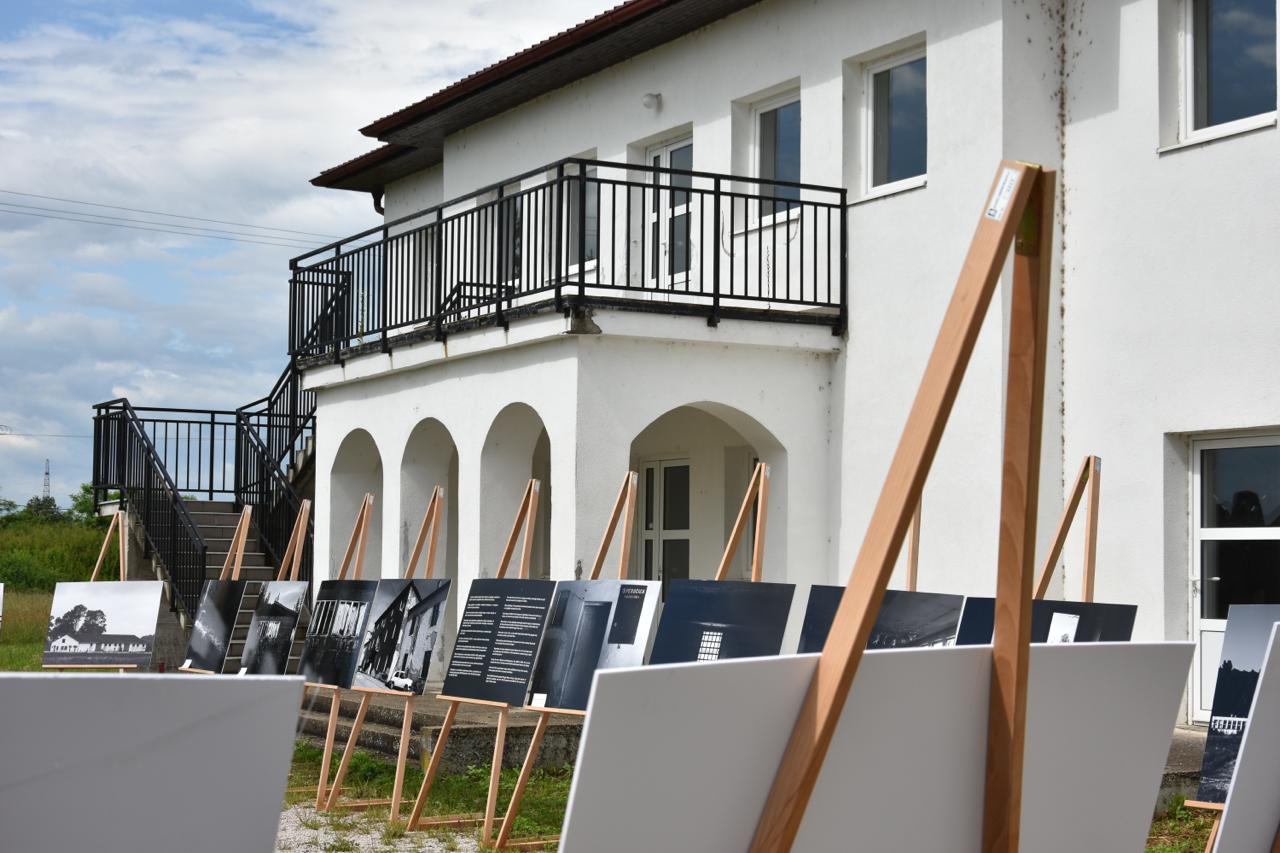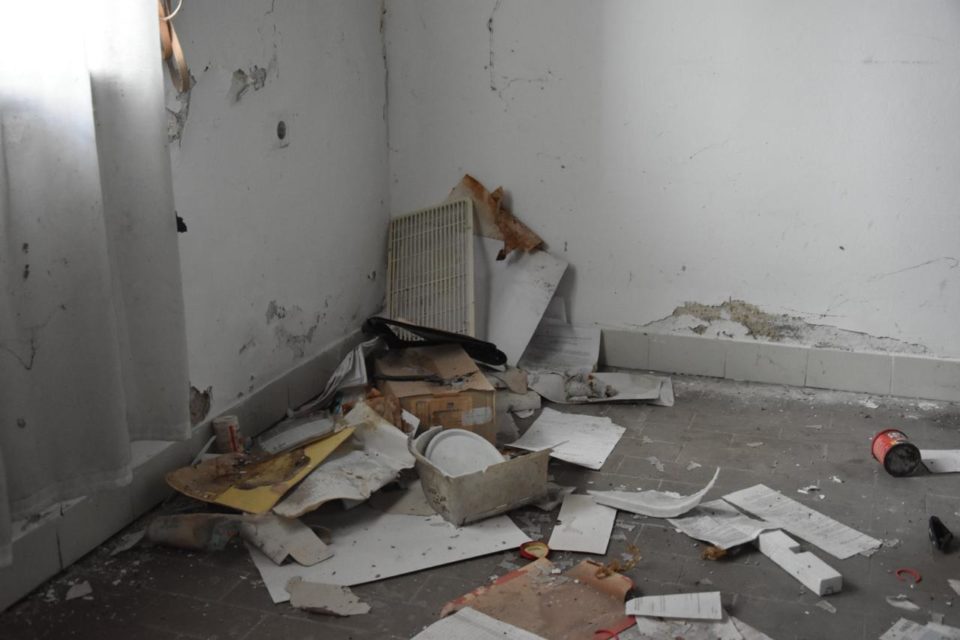
During the War in BiH, places of everyday life suddenly turned into epicenters of the most horrendous crimes imaginable. Schools and factories were transformed into campsites that were used to detain the civilian population and inflict collective trauma. The infamous camps in the Keraterm tile factory and the local school in Trnopolje offer insightful examples for analyzing the Bosnian Serb camp system during the war.
The camp system put in place by the Republika Srpska’s military forces in Bosnia and Herzegovina between 1992 and 1995 was an attempt to collectively traumatize an entire people. In Prijedor, a municipality located in the north-west of Bosnia, these three years saw a mechanism of “ethnic cleansing” and crimes against humanity at a level not seen in Europe since the Second World War. These were the camps Keraterm and Trnopolje, established by the Serb-led Prijedor Crisis Committee in 1992.
Concentration camps are defined by characteristics including forceful detainment, often without trial or with pre-determined trials, forced labor, and inhumane conditions (Britannica, 1998). Concentration camps have historically been utilized as a tool for regimes to remove their political or ethnic enemies from the rest of the population (Britannica, 1998). This is exactly what occurred in Keraterm and Trnopolje. Standard rules of law did not operate within the walls of these camps, leading to the brutal treatment of prisoners.
Prior to the war in Bosnia and Herzegovina, Europe’s most notorious camps system had been formed by Nazi Germany and its puppet regimes. The first was Dachau camp in 1933, with the final camps being liberated in 1945 (Wachsmann, 2024). Initially, the concentration camps were intended to isolate enemies of the Third Reich and ‘non-desirables’, primarily Jews, communists, Poles, Roma and Sinti. However, the goals of the Nazi regime changed when at the end of 1941, extermination camps started to be opened. This followed the Nazis’ “final solution to the Jewish question”, in which camps were built with the sole purpose of mass murder, differing from traditional concentration camp characteristics such as forced labor and detainment (Wiener Holocaust Library, 2020).
In contrast to Hitler’s death camps, the primary goal of the camps established by the ultranationalist Serbian Democratic Party (SDS) and its military forces was not to kill the non-Serb population. The main purpose of the camps was to displace non-Serbs from Serb-claimed areas, including the newly defined Autonomous Region of Krajina (ARK) in which Prijedor was situated, and collectively traumatize the non-Serb population. This did not mean however, that targeted killings did not occur. In the Keraterm camp established by the Crisis Committee, a branch of the ARK, approximately 150 people were massacred in what became known as the “hangar three massacre” on July 24th, 1992 (Vulliamy, 2012, p. 62).
Camp Objectives, Operations, and Discourse
Hikmet Karčić, a senior researcher of genocide studies at the University of Sarajevo, explains in his book, “Torture, Humiliate, Kill: Inside the Bosnian Serb Camp System”, that the goal of the camps in Bosnia and Herzegovina was to collectively traumatize the non-Serb population to the point of never wanting to return to their homes (Karčić, 2022, p. 6). Camps would employ a myriad of tactics with the intention of breaking down the individual’s humanity and permanently traumatizing them (Danner, 1997).
In contrast to the mechanical and almost robotic Nazi death camps, where prisoners were marched to the gas chambers by the thousands, the killings that were perpetrated in the Keraterm and Trnopolje camps were often personal and far more intimate, due to the fact that many prisoners and guards had come from the same neighborhoods and had known each other before the war. In Trnopolje camp, rape and abuse were used as tools to further traumatize the population, and often guards would allow ‘visitors’ to enter the camps (Karčić, 2022, p.133). These ‘visitors’ were commonly Serb civilians who were looking to settle a score with someone they knew before the war, or to enact ‘revenge’ for the historical mistreatment they believed had been committed against their ancestors at the hands of the Bosniaks and Croats from times gone by.
In order to weaponize the Bosnian Serb population against their neighbors, the SDS fed the community a plethora of hateful narratives by the SDS-controlled radio and news outlets (McDonald, 2017). SDS officials made frequent references to the defeat of Serbian forces by the Ottomans in the 1389 Battle of Kosovo, and the Serb genocide at the hands of the Croatian Ustaše fascist regime during the Second World War. These historical injustices were weaponized by the SDS to legitimize violence against non-Serbs. Such comments were made not only among SDS officials, such as in the RS Assembly, but also at public rallies both in Bosnia and in Serbia. This discourse was further fuelled by the SDS’ circulation of the Great Replacement Theory, according to which Bosnia’s Muslim population would supposedly ‘replace’ the Christian population through higher birth rates. In this way, Serbs were urged to fight for their freedom and for a “Greater Serbia”. This hateful rhetoric, along with other factors, successfully encouraged a portion of the Bosnian Serb population to turn on their non-Serb neighbors.

Abuse and Violence
While Keraterm and Trnopolje possess many similarities to one another, there are also notable differences. After Bosniak and Croat villages in the area were attacked, mostly men were taken to Keraterm, while the women and children were transferred to Trnopolje. Trnopolje also contained select amounts of men as well, but only those who were considered a “low security interest” (Karčić 2022, 132). Keraterm camp consisted primarily of men and is scarred with the events of murder, torture, and brutal interrogations, which primarily served to accomplish the goals of “ethnic cleansing”. While Trnopolje also witnessed atrocious acts of rape and execution, these murders were not systematic and the camp primarily served as a staging area for mass deportations of mostly women, children, and elderly men. These deportations were meant to take large masses of detainees to other areas outside of Prijedor, for example to Travnik, but would often result in mass executions at some remote site, especially if you were a male detainee (Karčić 2022, 133). Those who remained in the camps were subjected to living conditions that were worse than that of farm animals. The psychological torment of ritual humiliation and witnessing atrocities committed to one’s neighbors, paired with the physical torment of habitual beatings, starvation, lack of drinkable water, and disease had civilians “begg[ing] to be killed to escape the pain” (Basic 2015, 4).
The horror of the camps became etched in the world’s collective memory as journalistic images emerged showing half-starved, semi-naked prisoners staring out from behind barbed wire. Sexual violence, in particular, was one of the most prevalent forms of abuse that occurred at these sites. Rape and habitual beatings became an effective tool for perpetrating the kind of trauma that has the ability to inflict “a blow to the basic tissues of social life that damages the bonds attaching people together and impairs the prevailing sense of communality” (Boose 1995, 103). The United Nation’s General Assembly (UNGA) asserted in 1995 that the heinous practice of rape and abuse constitutes a deliberate weapon of war in fulfilling the policy of “ethnic cleansing” carried out by Serb(ian) forces in Bosnia-Herzegovina (Salzman 1998, 355).
The nightmarish accounts of sexual violence within the camps re-emerged during the 1997Tadić trial, the first international war crimes trial in history to prosecute rape separately as a war crime, and not solely in conjunction with other crimes. The chamber noted that, during confinement in the camps, “both male and female prisoners were subjected to severe mistreatment, which included beatings, sexual assaults, torture and executions” (Askin 1999, 101). One medical worker from Trnopolje was quoted during this session, detailing that, as this camp housed the largest number of women and girls, there were more rapes at this camp than at any other. He testified that groups of soldiers would routinely enter the camp and select victims at random to rape, with the youngest of the girls being around 12 years old. Gang rapes were also common, as the medical worker had attested to seeing a 19-year-old girl seek medical attention for hemorrhaging after being raped by seven soldiers at once. “When the rapes started”, he said, “they all lost hope…until then they had hope that this war could pass”, but the trauma of constant violence quickly broke their spirits. Sexual violence also extended past women, with men being frequently assaulted. During Tadić, witnesses “G” and “H” testified to being forced by Serb soldiers to sexually assault and even mutilate one another, both as forms of rape, humiliation, and destruction of community bonds (Prosecutor vs. Tadić, Case No. IT-94-1).
Dehumanizing Rhetoric in the Bosnian-Serb Camp System
The big question when analyzing such atrocities is still: how could this happen? What motivates large parts of society to systematically mobilize against a particular social group? Camps play a significant role here as they are places outside of law and order (Karčić 2022, 36). How is such a place created? How do the perpetrators legitimize their actions? The dehumanization of detainees is fundamental to any camp system. Dehumanization is a discursive strategy that makes a genocidal campaign possible in the first place by excluding a defined group from the social contract (Bećirević 2014, 47).
The dehumanization of Bosnian Muslims began long before the war and set the course for the construction of various camps. This discourse became increasingly evident in politics from the 1980s onwards, after the death of Tito and the disintegration of Yugoslavia (Cigar 2003). Serb nationalism focused on religious differences and conflicting historical narratives to perpetuate a divide between Serb and Bosniaks. On the one hand, violent action against the Muslim population was justified by referring to their purported ‘innate inferiority’. On the other hand, Bosnian Muslims were portrayed as a threat to Serb unity and safety. Bosniaks thus became the perfect enemy: inferior yet threatening.
Serb nationalist thought repeatedly portrayed Islam as the antithesis of Serb Orthodox Christianity that was forced onto the indigenous population by foreign oppressors. Conversion to Islam during Ottoman rule was therefore depicted as an act of betrayal and submission (Karčić 2022, 207). This is based on the assumption that Bosnian Muslims were in fact ‘treacherous’ Serbs who converted to Islam simply for personal gain (Karčić 2022, 207). The dehumanization of Bosniaks therefore drew from an ethno-historical narrative that equated Bosnian Muslims with foreign oppressors, which made them foreigners and traitors in their own country (Karčić 2022, 22). Muslims were pejoratively referred to as “Turks” (Kiper 2024, 81). This term was frequently used within the Bosnian Serb military and police forces who established and commanded the Keraterm and Trnopolje camps (Karčić 2022, 203). Years later, defendants before the ICTY continued to refer to Bosnian Muslims as “Turks”, revealing the persistence of such racialized rhetoric in their testimonies (Bećirević 2014, 161).
This kind of religious determinism targeted being Muslim as the only significant characteristic of Bosniaks, which not only denied them a distinct cultural identity but also the right to sovereignty. This kind of dehumanizing essentialism is reflected in the rhetoric of a camp commander in Trnopolje, Slobodan Kuruzović. A survivor testified that she had been raped several times by Kuruzović because he wanted “[…] to see how Muslim women f**k” (Karčić 2022, 133). Here, religion became the decisive characteristic that legitimized the routine abuse of female detainees in Trnopolje.
The demonization of Islam played an essential role in legitimizing the Bosnian-Serb war crimes to the international community. Political leaders such as the former president of the Republika Srpska, Radovan Karadžić, repeatedly claimed that the SDS was protecting European civilization against a Muslim invasion that would follow the establishment of an “Islamic state” in BiH. He regarded Serbs as “a formidable bulwark against Asiatic darkness” (Karadžić in Cigar 2003, 330). Thus, crimes against Bosniaks were justified by essentialist attributions that portrayed Muslims as inferior and dangerous.
This supposed inferiority was explained by SDS political figures such as Biljana Plavšić, in terms of what Norman Cigar (2003, 317) called “genetic racism”. Plavšić, a former biology professor who made a political career in the RS in the 1990s, advocated that only “genetically deformed material embraced Islam” (Shatzmiller 2002, 58). She used this rhetoric to justify her reluctance to negotiate with Bosniak leaders during the war (Shatzmiller 2002, 58 ) Plavšić became President of the RS after Karadžić’s resignation in 1996. In 2003, she was convicted by the ICTY of crimes against humanity and was sentenced to 11 years in prison. She was released after serving 8 years.
Another line of argument that served to legitimize the dehumanization of Bosnian Muslims refers to another dark chapter in human history: the Second World War. In Serb nationalist discourse, Bosniaks and Croats as entire communities were equally to blame for the crimes committed by the Ustaše regime against Serb civilians (Karčić 2022, 22). This historical narrative justified the genocidal project of the Bosnian Serb forces as revenge. Therefore Croats and Bosniaks were referred to as Ustaše, including on Radio Prijedor or during political assemblies (Karčić 2022, 108, 119). Furthermore, a survivor of Keraterm camp stated in front of the ICTY that his father had been beaten by Serb soldiers in the camp because one of them accused him of killing his father in 1942, during a fascist attack on the Yugoslav Partisans (Prosecutor v. Stakić, Case No. IT-97-24-T).
These rhetorics underpinned the creation of the Trnopolje and Keraterm camps, as well as the other Serb-run camps in Bosnia and Herzegovina. They sought to legitimize the genocidal campaign waged by the Serbian Democratic Party and put into place by its Crisis Committees. Keraterm and Trnopolje offer valuable examples in analyzing the complex position of camps in the War in BiH, and also illustrate the necessity of a multi-dimensional approach to the study of genocide.
—————-
This text was created with the support of the “SMART Balkans – Civil Society for Shared Society in the Western Balkans” regional project implemented by the Centar za promociju civilnog društva (CPCD), Center for Research and Policy Making (CRPM) and Institute for Democracy and Mediation (IDM) and financially supported by the Norwegian Ministry of Foreign Affairs (NMFA). The content of the publication is the sole responsibility of the project implementers and does not necessarily reflect the views of the Norwegian Ministry of Foreign Affairs (NMFA) or SMART Balkans consortium partners.








